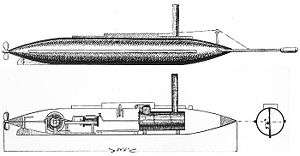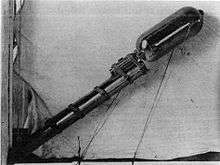Spar torpedo



A spar torpedo is a weapon consisting of a bomb placed at the end of a long pole, or spar, and attached to a boat. The weapon is used by running the end of the spar into the enemy ship. Spar torpedoes were often equipped with a barbed spear at the end, so it would stick to wooden hulls. A fuse could then be used to detonate it.
Invention
The spar torpedo was invented during the American Civil War by E. C. Singer, a private engineer who worked on secret projects for the benefit of the Confederate States of America (Singer was the nephew of Isaac Singer, inventor of the sewing machine). Singer's torpedo was detonated by means of a trigger mechanism adapted from a rifle lock (see flintlock mechanism for a similar device). The spring-loaded trigger[1] was detonated by means of a long cord attached to the attacking vessel. The attacking vessel rammed its target, embedding the barbed torpedo in its hull, then backed off. When the attacker reached the limit of the trigger cord, the torpedo was detonated.
Use

The most famous use of a spar torpedo was on the Confederate submarine H. L. Hunley, which managed to sink the Union screw sloop USS Housatonic on February 17, 1864, although the Hunley was lost. Spar torpedoes were also used on the David-class of semi-submersible attack boats.
At night on October 27–28, 1864, Lieutenant Cushing employed a spar torpedo to sink the Confederate ironclad ram CSS Albemarle. The sinking of the Albemarle was the Union navy's only successful sinking of a Confederate vessel by torpedo. Lieutenant Cushing employed a spar torpedo designed by John Lay.
The innovative semi-submersible 1864 Union craft USS Spuyten Duyvil employed a spar torpedo, but not with a barbed attachment to the target. Owing to an innovative directable and extensible spar, this craft could release a slightly buoyant mine underneath the target, which would be exploded by the means described above. (This craft was not employed against Confederate targets, but was used to clear wreckage from rivers.)
Spar torpedoes were also used on small wooden launches in the late 19th century, although they were not very useful weapons. The locomotive torpedo (the contemporary term for the modern self-propelled torpedo) replaced the spar torpedo as a weapon for submarines and small boats in the 1870s.
Spar torpedoes were also used by Romanian forces during the country's war of independence. On May 26, 1877, the craft Rândunica sank the Ottoman river monitor Seyfi on the Danube.[2]
Though the more advanced automotive torpedo (by Luppis and Whitehead) was looming in the end of the 19th century, French admiral Courbet made good use of the spar torpedo at the Battle of Foochow on August 23, 1884, where most of the Chinese Fujian Fleet under Admiral Ting was destroyed or sunk.
Sources
- ↑ "The Battle of Mobile Bay: "Damn the Torpedoes!"". Historical Marker Database. Retrieved 25 September 2015.
- ↑ Cristian Crăciunoiu, Romanian Navy Torpedo Boats, p. 19